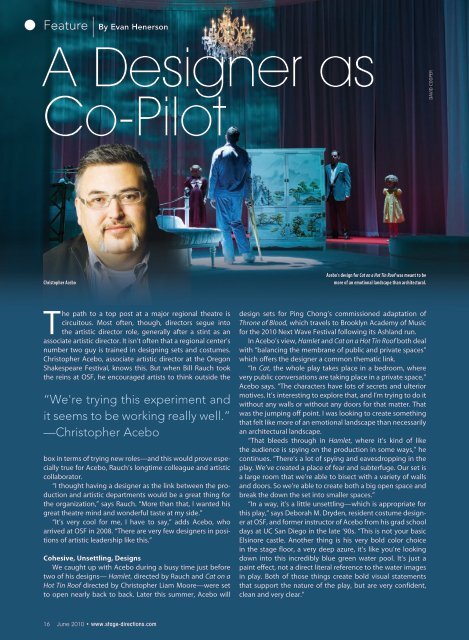Download a PDF - Stage Directions Magazine
Download a PDF - Stage Directions Magazine
Download a PDF - Stage Directions Magazine
Create successful ePaper yourself
Turn your PDF publications into a flip-book with our unique Google optimized e-Paper software.
Feature By Evan Henerson<br />
|<br />
A Designer as<br />
Co-Pilot<br />
David Cooper<br />
Christopher Acebo, associate artistic director at Oregon Shakespeare Festival, talks<br />
Christopher Acebo<br />
about his design work, and what it’s like for a designer to be involved in casting.<br />
The path to a top post at a major regional theatre is<br />
circuitous. Most often, though, directors segue into<br />
the artistic director role, generally after a stint as an<br />
associate artistic director. It isn’t often that a regional center’s<br />
number two guy is trained in designing sets and costumes.<br />
Christopher Acebo, associate artistic director at the Oregon<br />
Shakespeare Festival, knows this. But when Bill Rauch took<br />
the reins at OSF, he encouraged artists to think outside the<br />
“We're trying this experiment and<br />
it seems to be working really well.”<br />
—Christopher Acebo<br />
box in terms of trying new roles—and this would prove especially<br />
true for Acebo, Rauch’s longtime colleague and artistic<br />
collaborator.<br />
“I thought having a designer as the link between the production<br />
and artistic departments would be a great thing for<br />
the organization,” says Rauch. “More than that, I wanted his<br />
great theatre mind and wonderful taste at my side.”<br />
“It’s very cool for me, I have to say,” adds Acebo, who<br />
arrived at OSF in 2008. “There are very few designers in positions<br />
of artistic leadership like this.”<br />
Cohesive, Unsettling, Designs<br />
We caught up with Acebo during a busy time just before<br />
two of his designs— Hamlet, directed by Rauch and Cat on a<br />
Hot Tin Roof directed by Christopher Liam Moore—were set<br />
to open nearly back to back. Later this summer, Acebo will<br />
Acebo’s design for Cat on a Hot Tin Roof was meant to be<br />
more of an emotional landscape than architectural.<br />
design sets for Ping Chong’s commissioned adaptation of<br />
Throne of Blood, which travels to Brooklyn Academy of Music<br />
for the 2010 Next Wave Festival following its Ashland run.<br />
In Acebo’s view, Hamlet and Cat on a Hot Tin Roof both deal<br />
with “balancing the membrane of public and private spaces”<br />
which offers the designer a common thematic link.<br />
“In Cat, the whole play takes place in a bedroom, where<br />
very public conversations are taking place in a private space,”<br />
Acebo says. “The characters have lots of secrets and ulterior<br />
motives. It’s interesting to explore that, and I’m trying to do it<br />
without any walls or without any doors for that matter. That<br />
was the jumping off point. I was looking to create something<br />
that felt like more of an emotional landscape than necessarily<br />
an architectural landscape.<br />
“That bleeds through in Hamlet, where it’s kind of like<br />
the audience is spying on the production in some ways,” he<br />
continues. “There’s a lot of spying and eavesdropping in the<br />
play. We’ve created a place of fear and subterfuge. Our set is<br />
a large room that we’re able to bisect with a variety of walls<br />
and doors. So we’re able to create both a big open space and<br />
break the down the set into smaller spaces.”<br />
“In a way, it’s a little unsettling—which is appropriate for<br />
this play,” says Deborah M. Dryden, resident costume designer<br />
at OSF, and former instructor of Acebo from his grad school<br />
days at UC San Diego in the late ‘90s. “This is not your basic<br />
Elsinore castle. Another thing is his very bold color choice<br />
in the stage floor, a very deep azure, it’s like you’re looking<br />
down into this incredibly blue green water pool. It’s just a<br />
paint effect, not a direct literal reference to the water images<br />
in play. Both of those things create bold visual statements<br />
that support the nature of the play, but are very confident,<br />
clean and very clear.”<br />
16 June 2010 • www.stage-directions.com

















